|
Imagine coming for the first time to the Santa Fe Opera. You've seen the elegant structure from the road to Taos, perched like a giant grasshopper on top of a hill. You don't expect too much from a small company, not much in particular from your first opera here, Jacques Offenbach's Les Contes d'Hoffmann ( The Tales of Hoffmann), one of those repertory horses that tend to be lame. You think it's good enough to sit in the open air, under the winged grasshopper roof and see the mountains, piles of clouds on both sides of the stage, threatening thunder, feel the brooding night air after sunset. The setting itself, with its many wind-sheltered patios and 360 degree views, seems to compensate for any potential artistic shortcomings.
 |
Then something unexpected happens. You are right away gripped by a libretto and music you have never heard quite like this; an act later you are at the edge of your seat because for the first time, those Tales are fascinating; and finally, past midnight, you are too excited to go to your hotel and sleep: you are caught in the rare artistic and musical revelation that makes you want to instantly see this opera again. Too much has been offered by the director, Christopher Alden, the conductor, Stephen Lord, the choreographer, Seán Curran, and the excellent cast, to take in all at once: a cornucopia of ideas, emotions, intricate story connections...
It took me two viewings and some research to figure out this apparent miracle that changed my expectations about Santa Fe Opera and my ideas about Offenbach's only serious opera, his final, famously unfinished work that was endlessly tinkered with since its premiere in 1788, after the composer's death. To cite a recent example, last season's Met version, broadcast "Live in HD," was a rather conventional Hoffmann, well sung by the likes of Anna Netrebko (Antonia), Kathleen Kim (Olympia), John Calleja (Hoffmann) but with nothing to say. No matter the veneer of "surrealist" decorations and Bowler hats à la Magritte: the production by Bartlett Sher wore the same old hat, just adding some vulgar Broadway nakedness and glitz.
This is the basic plot: The poet E.T. A. Hoffmann (a real-life figure of German Romanticism) is in love with an opera diva, Stella, who only appears for one minute but represents the three types of women E.T.A. Hoffmann has written about in his tales: the mechanical doll Olympia, the singer Antonia who must not sing, and the Venetian courtesan Giulietta who is in cohouts with the devil. In the Prologue, Hoffmann sets out to tell a group of hard-drinking fraternity students in a Nuremberg tavern about his failed love affairs with these women (who tend to inspire male artists) – the doomed innocent girl, the glamorous femme fatale, the perfect (if not yet inflatable) doll. The stories are shown as flash-backs, each amorata gets her own act, then we are back in the tavern for an Epilogue.
A certain tension in this predictable story comes from the artist's opponent, the devil in various disguises who spoils the poet's love affairs, and from his ally, the Muse who accompanies Hoffmann in the guise of his student Niklausse. The match ends in ambiguity: the devil walks off with Stella; Hoffmann, too drunk to keep his rendez-vous with the diva after her performance in Don Giovanni, has nothing left but his alcohol. But the Muse consoles him: he still has her and his poetic inspiration.
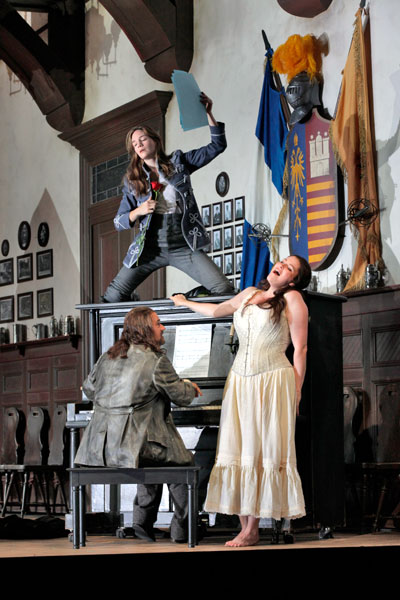 |
The fault with this ever popular opera is that it promises much more than it usually delivers. This is partly the fault of the libretto that has been stripped in the course of centuries to the bare bone with little meat left from the original dark, romantic material Offenbach worked with. E.T.A. Hoffmann was a precursor of Edgar Allen Poe and the Danish master story-teller Isak Dinesen, but he is mostly known to Americans through the ballets Coppelia and The Nutcracker. His tales of Olympia, Antonia and Guilietta are filled with demonic forces, biting irony, despair and madness. Unfortunately, because Offenbach didn't have time to finish his work, every opera company and director took license with Hoffmann with the excuse (still used today by the Met) that nobody really knows what the composer intended. The German-Jewish composer who worked in Paris already had two different versions in mind, one with a great amount of spoken text, the other with recitatives. Clearly he felt there was a lot to say apart from the orchestral score. But the traditional opera version that got established around 1900 reduced The Tales of Hoffmann to bare-bone, seemingly absurd, drunken fantasies. Along with the text, the music, too, was stripped and brought down to echo the successful operettas of this "Mozart of the Champs-Elysées".
As it happens, however, in the history of opera, every now and then discoveries are made. Some twenty years ago, in the 1980s, extensive working notes and manuscripts of Offenbach's from the family's coffers were auctioned off at Sothebys and ended up at Yale. A musicologist of talent and vision, Michael Kaye, took hold of them, gathered all the manuscripts, autographs, libretto notes that had been dispersed in private and public collections, and set out to construct or reconstruct "the proper thing" — a version of the opera that made sense and restored its richness. (I owe this information to a fascinating article by James M. Keller in Pasatiempo, July 16, 2010.) The so-called "Kaye version" cuts a lot of unauthenticated, mediocre music, edits and adds melodies and spoken text; it will be published in the 43-volume Offenbach Critical Edition (co-authored by a French musicologist, Jean-Christophe Keck who came to similar results for Hoffmann and is overseeing the edition.) The finally "definitive" Tales of Hoffman even convinced James Levine at the Met, but last year, alas, the Met decided to stick with the old war horse, after all...
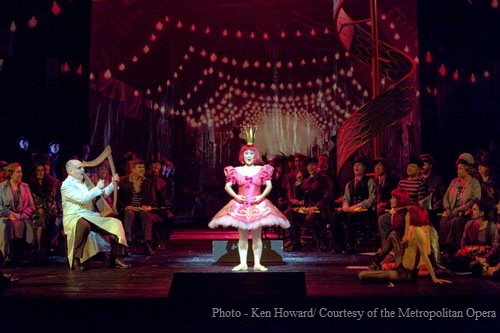 |
A visionary conductor, however, Stephen Lord, who was recently chosen by Opera News as one of the "25 Most Powerful Names in U.S. Opera" (one of four conductors), had already picked up the Kaye version and performed it at Boston Lyrik Opera and Opera Theatre of Saint Louis, where he is the music director. Opera Santa Fe engaged him together with the famously eccentric director Christopher Alden and made the restored Hoffmann a high point of this year's summer.
In a striking irony of casting, Kate Lindsay, the same young mezzo who sang the role of Niklausse, Hoffmann's Muse, at the Met, sings the restored Niklausse at Santa Fe Opera. In the Met version, she is sorely underused, gets nothing much to sing, is simply a beautiful, ironically smiling shadow presence. Now she is a main agent of the story, an equal player with lots of spoken text (which she delivers in relaxed French) and a couple of beautiful songs. Endowed with the sexy movements of a ballet dancer and a small, but interesting, edgy and at times stirringly beautiful voice, Lindsay here is revealed as the ultimate performer who can deliver a commentary on the wild, demented states of Hoffmann's passions in pure body language. Her Muse is as capricious as artistic inspiration tends to be. She is moody, changes easily from female to male, boy to girl, is possessive of Hoffmann and critical of his love objects because they are "undeserving"; wants the poet to drown his memories in alcohol and tend to his art rather than to his sexual obsessions. She even makes herself an accomplice to the devil so Hoffmann can do her bidding.
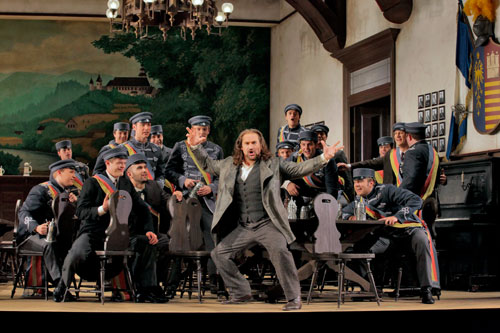 |
If just one figure in this opera can bring in a complexity that was never there before, only vaguely hinted at, expect to find still more. Santa Fe has a passionate, dissolute Hoffmann in tenor Paul Groves; a solid bariton, Wayne Tigges, as each of Hoffmann's four detractors, and the absurdly funny David Cangelosi in all the servant roles. Last but not least, there is Canadian soprano Erin Wall who does what Anna Netrebko had planned to do at the Met before resigning herself to just the Antonia act: Erin Wall courageously sings Olympia, Antonia, Giulietta and of course appears as Stella as well. With her beauty, acting skills and her strong but lyrical voice (it did not matter the least to me that her coloratura doesn't match other famous Olympias, like Nathalie Dessay), I wouldn't be surprised if she were one of the young stars regularly rising from Santa Fe Opera to enter a big career.
However, the main star of this production is the entire cast under director Christopher Alden, whipping up the emotional turmoil and macabre spirit of the Romantic era. Ably assisted by choreographer Seàn Curran, Alden uses the soloists and the opera chorus (fraternity students, ball guests, bordello girls and their clients) in scenes that are dark, suspenseful and psychlogically bizarre, coming closer to the intensity of E.T.A. Hoffmann's romanticism. With a masterly hand, he holds the reins of this new Tales of Hoffmann, a mad-cap gallop with moments of exhilarating humor and beauty — all of it driven and sustained by conductor London's inspired reading of the restored score.
In Act I, the Met production presented Olympia as just the usual wind-up doll, letting the singer deliver her coloratura acrobatics with automaton movements. A doll can be fun to watch, but I am never convinced. I keep thinking: what an idiot, this Hoffmann. Sure, he literally wears the „pink glasses all lovers wear" but how could a poet, even a young poet, be this blind? This standard version serves up E.T.A. Hoffmann's story as a joke that has been told too many times. In Aulden's version of the Olympia act, every male guest in the fine society that the dollmaker has invited to the debut of his „daughter" looks at her through the devil's opera glasses. So does Hoffmann. The moment he picks up his opera glasses, the stage turns pink. Olympia, dressed in a ravishing crinoline gown, glows on a pedestal with her own "stage set" of bourgeois happiness: easy chair, potted palm tree and tea set. The doll has been programmed to serve tea, and so she does – but magically, as the pink glow brings her to life. The audience sees her as Hoffmann imagines her: a young woman of a strangely remote seriousness and grace, who suddenly collapses into her tea cup – Hoffmann has let his glasses sink.
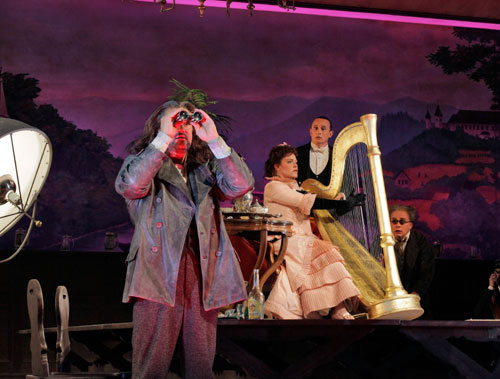 |
Olympia's other trick, apart from exclaiming "Oui! Oui!" (Yes! Yes!) to any question she is asked, is singing and playing her harp. The exchanges between the pair are touching and suspenseful at first, as the young woman remains alluringly remote and anxious throughout their flirtation. There are the expected funny moments when Hoffmann needs to wipe the steam off his glasses and Olympia gets stuck on a shrill, repetitive note. But they turn more absurd as Hoffmann stops looking at his love object and, instead, stares at his happy fantasy somewhere in space. At the height of his ecstasy, Olympia executes her limited repertoire: she incongruously descends a cup of tea at him from her pedestal.
The humor of the scene comes from the double vision it creates for the audience: the inapt automaton does what any well-programmed automaton would end up doing, but it fits what a well-bred girl in her first nervous tête à tête with an admirer might also do. The poet, brought out of his rhapsody, promptly breaks the cup and breaks the spell. The scene culminates in chaos when Olympia, reprogammed by the devilish Coppelius, starts misbehaving. She begins to make out with Hoffmann, stiffly climbing all over him. When stopped, her coloratura turns furious; she attacks her "stage set,"—ilariously pulls her bourgeois palm tree from its pot, and starts tearing off her dress...
It seems to be almost Hoffmannesque magic that Olympia is a believable character in both the doll and the live young woman who is not quite alive. The gain is first of all musical: the "live" Olympia gives the songs she performs an emotional and tumultuous resonance that is excluded if Olympia is just a one-dimensional puppet. But similarly rewarding is the psychology Alden gets out of the scene. Listen for a moment to the original text of E.T.A. Hoffmann's tale about Olympia (in "The Sandman"):
"From the profoundest depths of his writing-desk Nathaniel (the stand-in for Hoffmann) fetched up everything he had ever written: peoms fantasies, visions, novels, tales, daily augmented by random sonnets, stanzas, canzoni and he read them all to Olympia without wearying for hours on end. And he had never before had so marvelous an auditor: she did not sew or knit, she did not gaze out to the window, she did not feed a cage bird, she did not play with a lapdog or with a favourite cat, she did not fiddle with a handkerchief or with anything else, she did not find it necessary to stifle a yawn with a little forced cough – in short, she sat motionless, her gaze fixed on the eyes of her beloved with a look that grew ever more animated and more passionate. Only when Nathaniel finally rose and kissed her hand – and no doubt her mouth, too – did she say: 'Ah, ah!' and then: 'Good night, my dear!'
"'O you glorious, profound nature,' Nathaniel exclaimed when back in his room, 'only you, you alone, understand me completely.'"
And when the true, truly artful nature of Olympia has been revealed to everyone, E.T.A. Hoffmann concludes:
"But the minds of many esteemed gentlemen were stll not set: the episode of the automaton had struck deep roots into their souls, and there stealthily arose in fact a detectable mistrust of the human form. To be quite convinced they were not in love with a wooden doll, many enamoured young men demanded that their young ladies should sing and dance in a less than perfect manner, that while being read to they should knit, sew, play with their puppy and so on, but above all that they should not merely listen but sometimes speak too…"
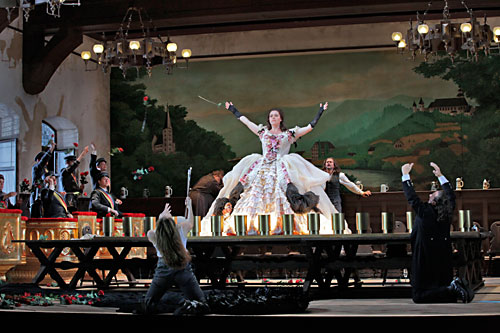 |
In Alden's staging, the new Tales of Hoffmann inspire a continuous reflection on art and illusion, performance and truth, poetic inspiration and demonic obsession. There are many brilliant moments when the director uses the extended libretto and music to make his point. The basic sameness of the four heroines (following Offenbach's intention to the letter) is mirrored in the unity of the stage set. The German Bierkeller, the tavern in Nuremberg, with nationalist flags and an upright piano, remains the background; its simple wooden tables serve as podiums and runways, the chairs move around. A few sparse, but dramatically well-used elements – like Olympia's cozy corner — create the atmosphere of every act. The poet Hoffmann is often shown at a table, drinking and drunk and writing: he may be dreaming up, making up the very scenes he is involved in. He brings his texts to his lovers like courting gifts. In Act II, the Antonia act, his texts are on the piano when Hoffmann accompanies the young woman and we suddenly get a new sense of Antonia's beautiful "Tourterelle" song: this song about the dove, now remembered together, once was Hoffmann's love poem written for her.
But Hoffmann is jealous of Antonia's music and her potentially promising career. He agrees with her father who wants to forbid her to sing because she might die from the intensity of her singing, the way her mother died. The Muse, however, just like the devil, begs to disagree. While Antonia hears her mother beckoning, is torn between her conflicted feelings and sings her heart out, she is dressed up in a fabulous stage dress and a whole opera balcony drives out of the wings, filled with young men, the lusty fraternity students of the Prologue. In a striking tableau vivant all the young men train their opera glasses on their new darling diva with eager fascination. Antonia is an obvious stand-in for Stella. Director Alden lets her expire on the stage, with the Muse wildly conducting. But it's just a stage death; grand opera has to end that way. The diva rises again as if from the balloon of her skirts – covered by a rain of red roses from the balcony– and takes her bow. Hoffmann tries to rush her from the stage, but she shoves him aside.
Art and artful illusion have won a second victory over love.
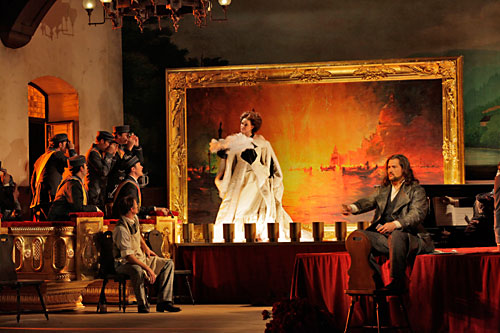 |
The illusion of love, rooted in performance, is brought to a perverse crescendo in Act III. A huge painting of Venice in a luscious Turner style is fronted by a cat-walk for the courtesan Giulietta who performs her seduction of Hoffmann for the same full balcony of young men who now watch her in the company of escorts in corseted undergarments. The mood of the scene leaves no doubt that Offenbach intended it to be the last act (in the conventional version it is often placed, illogically, between the Olympia and Antonia acts). By now Hoffmann has only bitter cyncism left about love (small wonder) but his abdication challenges the devil to tempt him again, in spite of all. The bordello is a hall of mirrors, delusions. There are blind mirrors everywhere – Hoffmann will have to pay for Giulietta's favors with his reflection, just as her lover Peter Schlémil had to pay with his shadow (another one of E.T.A. Hoffmann's tales woven into the opera). A long line of prostitutes walks in during Guiletta's "show", in dark corsets and black masks, holding hands, heads bent like a chain of slaves. They settle in a provocative pose at the front stage, staring blindly at the audience, while the elegant cocquette waves her plumed fan for her admirers. For a moment, Hoffmann's Muse is caught in an empty picture frame – a moment that created great confusion in most critics of this production: why on earth an empty picture frame? But couldn't her inspiration, too, be the target of the devil and her promises turn out to be empty, after all?
On this ambiguity rests the Epilogue. This time, the devil (in the guise of the rich industrialist Lindorf) does not walk off with the Diva Stella. The students clamor for the burning Punsch drink; the Devil wrests away Hoffmann's poems from the Muse and distributes them to the main protagonists of the story who pass them over the flaming bowl of alcohol in a solemn ritual that could be seen as symbolic of destruction and/or as a fire offering to the Gods. Hoffmann, kneeling on the floor surrounded by the others, appears crucified to the tavern table, having sacrificed everything to his ephemeral art. Offenbach's famous septet (often left out or placed somewhere else) gives a musically stirring, bravoura ending to the night: "On est grand par l'amour et plus grand par les pleurs." (One becomes great through love and greater through tears.)
The meaning seems clear: artistic inspiration (the Muse) and the demonic (the Greek daemon) are inspeparable. The devil's tools in The Tales of Hoffmann — women, wine and narcissism — would have destroyed a normal man, murdered his soul, but they have perhaps redeemed the artist's soul. In this brilliant unconventional production the artist's soul has undoubtedly been redeemed.
Other Santa Fe operas in brief:
Albert Herring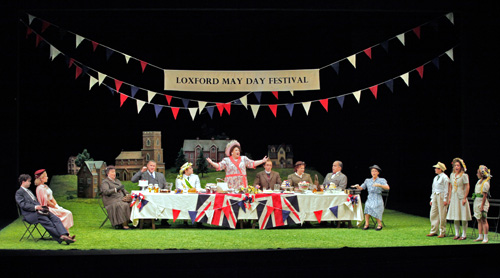
I also saw Albert Herring, a merry early opera by Benjamin Britten, about an extremely shy young man in a British village who is crowned May King because the Grande Dame of the village, Lady Billows, can't find a young maiden clean and couth enough to wear the crown. Directed by Paul Curran and conducted by Sir Andrew Davis, it's done with panache and great caricatural fun by the whole cast, with an outstandingly billowing Lady, Christine Brewer (whose shrill top notes notably fit the character) and her hilarious housekeeper, Jill Grove, who knows the gossip about everyone's dirty linen in the village. Kate Lindsay here has abandoned the androgynous attire from Hoffmann and is all-feminine and charming as Nancy, a young village woman in love.The protagonist, Albert, is expertly sung and acted by one of the winners of the Met documentary The Audition: Alek Shrader (who hit the 9 high Cs in his aria from La Fille du Régiment). His character, an awkward outsider in this provincial society, is an obvious red herring for the gay composer himself. Britten's music sounds like the precise dawn of what he would soon compose at his zenith for The Turn of the Screw. If you didn't know better you would swear Albert Herring was the light-weight dessert copied from the main dish of the later serious opera.
Madame Butterfly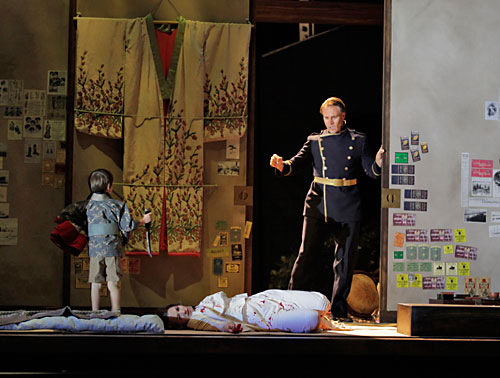
An angry Madame Butterfly was a first for me — a convincing rendition by soprano Kelly Kaduce in Lee Blakely's beautifully staged production. This steely Cio-Cio-San is so determind to become "American" that she cuts her hair, wears an American-style dress, and lets her feelings of rage and outrage fly. It's a refreshing change from the delicate flower stereotype, especially as her American "vagabondo," B. F. Pinkerton, the lieutenant who marries her for 999 years with the right to cancel the contract any time, is played by honey-voiced tenor Brandon Janovich with a crude "everyone loves Americans" attitude of egotism and sexual greed. Her suicide is sung and played as a terrific aggression in front of her blind-folded little son just before Pinkerton rushes in, crying out for her. The child, who has torn off the blind-fold and seen his blood-covered mother on the floor, picks up the dagger, backing away from the huge man who reaches out his huge white hands in helpless pleading. A great moment of operatic theater that begs for the sequel that has never been written…
The Magic Flute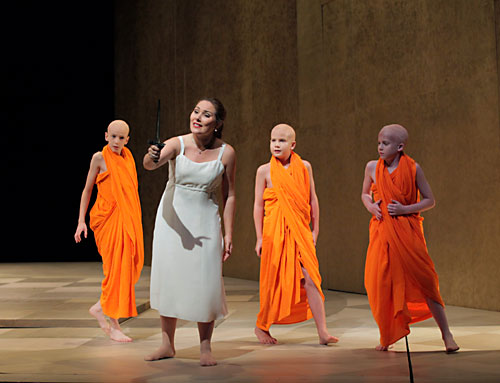
Just as I began to wonder if Sante Fe Opera was perhaps reaching to the stars by being flawless for en entire season, I was hit by Tim Albery's production of Mozart's Magic Flute, an example of "good intentions leading to hell." Albery tried for simplicity and instead achieved simple-mindedness. The ugly press-wood stage box of designer Tobias Hoheisel was the symbol of an absence of ideas and magic, and it didn't help that Hoheisel was also responsible for the costumes. The "parental" set of characters was in Mozartian dress, the villain and his men in modern dictatorial military look with sun glasses, and the young generation – Pamina, Papageno and Papagena – sported baseball caps, sneakers and ponytails. The Prince, strapping tenor Charles Castronovo, faired a little better and was able to show his buff naked torso, but I was sorry for lovely Russian Ekaterina Siurina whose innocent, pure voice would have deserved something shining, stellar on her and around her, instead of everyday American banality of dress. Worst off, however, were the three young boys, Mozart's "Spirits," who had to mosey about as Bhuddist monks. Three monklets with big naked skulls and bizarrly anorexic arms. To add insult to injury, they were rendered neckless by the clumsy cut of their orange tunics and it was no surprise that their singing was a misery, paper-thin and too often, alas, off-key. The large amount of spoken text in this opera was said in badly translated modern-day American in the style of "Hey, Dude, can you tell me where to find a gal around here?" Then suddenly all the American language got lost in the stark Italian accent of Andrea Silvestrelli's Sarastro, who seemed to speak Free-Masonese. The uninspired conducting of Lawrence Renes was protective of the singers to the degree that their fine voices at times came across as almost a capella, which unfortunately heightened the temptation to flee into sleep.
Should I confess that this one striking failure came almost as a relief, as I don't easily believe in miracles?
But three highly successful operas in a row, two dramas, one comedy, during one short summer seaon are a small miracle all in itself, rare at most opera houses, even at the Met.
Photos - Courtesy Santa Fe Opera
|



